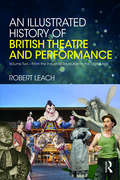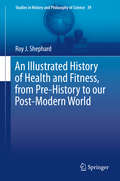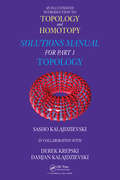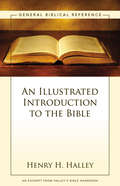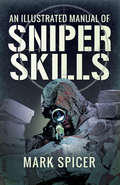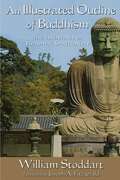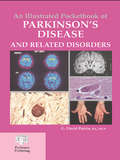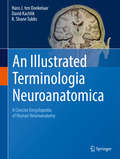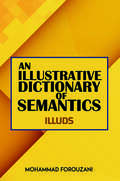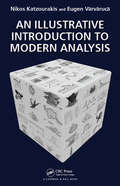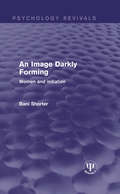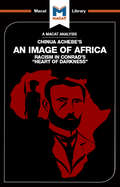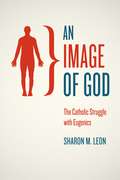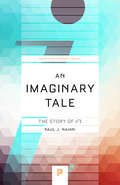- Table View
- List View
An Illustrated History of British Theatre and Performance: Volume Two - From the Industrial Revolution to the Digital Age
by Robert LeachAn Illustrated History of British Theatre and Performance chronicles the history and development of theatre from the Roman era to the present day. As the most public of arts, theatre constantly interacted with changing social, political and intellectual movements and ideas, and Robert Leach’s masterful work restores to the foreground of this evolution the contributions of women, gay people and ethnic minorities, as well as the theatres of the English regions, and of Wales and Scotland. Highly illustrated chapters trace the development of theatre through major plays from each period; evaluations of playwrights; contemporary dramatic theory; acting and acting companies; dance and music; the theatre buildings themselves; and the audience, while also highlighting enduring features of British theatre, from comic gags to the use of props. Continuing on from the Enlightenment, Volume Two of An Illustrated History of British Theatre and Performance leads its readers from the drama and performances of the Industrial Revolution to the latest digital theatre. Moving from Punch and Judy, castle spectres and penny showmen to Modernism and Postdramatic Theatre, Leach’s second volume triumphantly completes a collated account of all the British Theatre History knowledge anyone could ever need.
An Illustrated History of Duke Basketball: A Legacy of Achievement
by Mike Krzyzewski Ben Cohen Bill BrillNo college in America has dominated the basketball scene the way Duke has. From the ?rst game in 1906 through the NCAA National Championship following the 2009-10 season, 100 Seasons of Duke Basketball provides fans with an insider's look at Duke basketball and the people who have made it a national legend-Vic Bubas, Eddie Cameron, Art Heyman, Mike Krzyzewski, and many others.
An Illustrated History of Health and Fitness, from Pre-History to our Post-Modern World (Studies in History and Philosophy of Science #39)
by Roy J. ShephardThis book examines the health/fitness interaction in an historical context. Beginning in primitive hunter-gatherer communities, where survival required adequate physical activity, it goes on to consider changes in health and physical activity at subsequent stages in the evolution of "civilization. " It focuses on the health impacts of a growing understanding of medicine and physiology, and the emergence of a middle-class with the time and money to choose between active and passive leisure pursuits. The book reflects on urbanization and industrialization in relation to the need for public health measures, and the ever-diminishing physical demands of the work-place. It then evaluates the attitudes of prelates, politicians, philosophers and teachers at each stage of the process. Finally, the book explores professional and governmental initiatives to increase public involvement in active leisure through various school, worksite, recreational and sports programmes.
An Illustrated History of Palm Beach: How Palm Beach Evolved over 150 years from Wilderness to Wonderland
by The Historical Society of Palm Beach CountyAn Illustrated History of Palm Beach is a nostalgic journey through the history of the town of Palm Beach as told through the photographic collection of the Historical Society of Palm Beach County. From an early pioneer community, Palm Beach evolved over the past 150 years into today's sophisticated resort, starting with the grand hotels of Henry Flagler, the Royal Poinciana and The Breakers, and elegant mansions of the Gilded Age. An Illustrated History of Palm Beach is a primary source look into the development of one of America's most prosperous and enchanting communities.
An Illustrated History of the Mandala: From Its Genesis to the Kalacakratantra
by Kimiaki TanakaEveryone’s heard of mandalas; now we have a uniquely rich history and explanation of their history and meaning.This book is a history of the genesis and development of the mandala from the fifth and sixth centuries, when the mandala first appeared in India, to the eleventh century, when the Kalacakratantra appeared just before the disappearance of Buddhism in India. The 600 years of Indian esoteric Buddhism that concluded the 1,700-year history of Indian Buddhism could be said to have been the history of the development of the mandala. (The Kalacakratantra integrated earlier mandala theories into a single system and established a monumental system unprecedented in the history of esoteric Buddhism. It was thus the culmination of the development of Indian Buddhism over a period of 1,700 years.) The analysis is at the micro level and includes numerous illustrations and charts. Particular attention is paid to proper names, mudras, and mantras that have been overlooked by scholars in philosophy and doctrine, and the author tackles issues that cannot be explained solely from a historical viewpoint, such as geometric patterns, the arrangement of deities, the colors, and their meaning in Buddhist doctrine.
An Illustrated Introduction to Topology and Homotopy
by Sasho KalajdzievskiAn Illustrated Introduction to Topology and Homotopy explores the beauty of topology and homotopy theory in a direct and engaging manner while illustrating the power of the theory through many, often surprising, applications. This self-contained book takes a visual and rigorous approach that incorporates both extensive illustrations and full proofs
An Illustrated Introduction to Topology and Homotopy Solutions Manual for Part 1 Topology
by Sasho Kalajdzievski Derek Krepski Damjan KalajdzievskiThis solution manual accompanies the first part of the book An Illustrated Introduction toTopology and Homotopy by the same author. Except for a small number of exercises inthe first few sections, we provide solutions of the (228) odd-numbered problemsappearing in first part of the book (Topology). The primary targets of this manual are thestudents of topology. This set is not disjoint from the set of instructors of topologycourses, who may also find this manual useful as a source of examples, exam problems,etc.
An Illustrated Introduction to the Bible: A Zondervan Digital Short
by Henry H. HalleyDerived from Halley’s Bible Handbook, a world-renowned, accessible guide to the Bible now in its twenty-fifth edition, this digital short explains simply and clearly how the Bible was written and what it is about. Readers looking for a basic introduction to the Bible or wanting a tool to teach others about it will find An Illustrated Introduction to the Bible to be a handy resource.
An Illustrated Journey: Inspiration From the Private Art Journals of Traveling Artists, Illustrators and Designers
by Danny GregoryTravel + Sketching = InspirationWhen we travel, we don't want to follow the same itinerary as everyone who's come before us. We want to feel like explorers, adventurers in undiscovered territory. And that's exactly what sketching can bring to the travel experience.An Illustrated Journey captures the world through the eyes of 40 talented artists, illustrators and designers. You'll experience the wonder of seeing familiar sights through a fresh lens but, more important, you'll be inspired to set pen to paper and capture your own vistas.The really wonderful thing about a sketchbook is that it can be totally private. You don't have to have an ounce of talent to enjoy learning how to really see what's in front of you. But lucky for us, the sketchbooks captured here are lovely, creative, intimate windows into each artist's mind.So, whether you're just returning to the art of drawing, abandoned by most of us after childhood, or you're looking for inspiration to take your illustration work in a new direction, An Illustrated Journey will take you on a wonderful trip of the imagination. All you need to pack are a pencil and a piece of paper.
An Illustrated Life of Christ Presented to the Chinese Emperor: The History of Jincheng shuxiang (1640) (Monumenta Serica Monograph Series)
by Nicolas StandaertA renewed attention to visual culture is one of the recent developments in the study of cultural contacts between China and Europe in the seventeenth and eighteenth centuries. The subject of this book is the illustrated Life of Christ presented to the Chinese emperor in 1640 by the Jesuit missionary Johann Adam Schall von Bell S.J. (1592-1666). The origin of the work is a small parchment booklet with coloured miniature paintings based on a wide variety of prints by well-known European engravers (e.g., H. Goltzius, J. Stradanus). It was compiled in Munich in 1617 and a Chinese version with the title Jincheng shuxiang was published in Beijing more than twenty years later in a nicely illustrated edition. An Illustrated Life of Christ is a fascinating analysis of one of the earliest artistic encounters between Europe and China...Standaert has, once again, demonstrated his scholarly foresight, workmanship and authority. John T.P. Lai in Journal of the History of Christianity in Modern China This book is composed of two parts. Part I traces the complex history of production of Jincheng shuxiang, from its European origin to its Chinese reception. It also analyses the illustrations and the text. Part II contains the reproduction of the Chinese text and 48 illustrations, the reproduction of the identified original European prints and a translation of the Chinese text. It is hoped that the wider diffusion of this rare primary source, which is now reprinted for the first time since the seventeenth century, will further stimulate the study of visual culture in Sino-Western relations. The book will be of interest to a broad range of scholars, from art historians of China and Europe to scholars interested in print history, and theologians.
An Illustrated Manual of Sniper Skills
by Mark SpicerThis heavily illustrated manual offers an in-depth look at the art of sniping in war and anti-terrorist environments. Drawing on a vast, firsthand knowledge of sniper skills, former British Army sniper and sniper instructor Mark Spicer describes the role of the sniper in peace and in war, in reconnaissance and counter-surveillance, in cities, in vehicles, at night and by day. He presents crucial information about training and equipment, judgment and positioning, details of great relevance to professional marksmen, both military and law enforcement. This comprehensive manual will also be of interest to hunters, weapons enthusiasts, competition shooters, and paintball participants. The authoritative text is complimented by 280 full color illustrations, diagrams, and related information.
An Illustrated Outline of Buddhism: The Essentials of Buddhist Spirituality
by William StoddartAnIllustrated Outline of Buddhism is an ideal introduction to the vast and complex field of Buddhism, a world religion with more than a billion followers. In its short format and accessible style, it presents the essential features of the Buddhist religion with a clear yet concise style that is suitable for both the general reader and student of Buddhism. This fully color edition contains 40 color illustrations, including a stunning array of outstanding examples of Buddhist art, architecture, statuary, and calligraphy. Numerous maps, diagrams, and charts are included to illustrate important aspects of Buddhist beliefs and to summarize the different cultural forms and developmental phases of Buddhism. A select bibliography for further reading and a detailed index will also aid the reader.
An Illustrated Pocketbook of Parkinson's Disease and Related Disorders
by G. David PerkinAn authoritative introduction to Parkinson's disease and its related disorders and syndromes, this book provides a concise overview of the disease and its diagnosis and management. The author presents samples of clinical, investigative (CT, MRI, and PET), and pathological images with succinct descriptive text of the disorders featured. He describes
An Illustrated Terminologia Neuroanatomica: A Concise Encyclopedia of Human Neuroanatomy
by R. Shane Tubbs Hans J. ten Donkelaar David KachlíkThis book is unique in that it provides the reader with the most up-to-date terminology used to describe the human nervous system (central and peripheral) and the related sensory organs, i.e., the Terminologia Neuroanatomica (TNA), the official terminology of the IFAA (International Federation of Associations of Anatomists). The book provides a succinct but detailed review of the neuroanatomical structures of the human body and will greatly benefit not only various specialists such as (neuro)anatomists, neurologists and neuroscientists, but also students taking neuroanatomy and neuroscience courses. The book offers a high yield, combined presentation of neuroanatomical illustrations and text and provides the reader a ‘one-stop source’ for studying the intricacies of the human nervous system and its sensory organs. It includes an alphabetical list of official English terms and synonyms with the official Latin terms and synonyms from the TNA. With regard to the entries, the name of the item in standardized English is provided, followed by synonyms and the official TNA Latin term, Latin synonyms and eponyms, a short description and in many cases one or more illustrations. To facilitate the use of illustrations, certain entries such as the gyri or sulci of the cerebral cortex are presented together with extensive cross-references. Terms that form part of a certain structure (such as the amygdaloid body, the thalamus and the hypothalamus) are listed under the respective structure. Segments and branches of arteries are discussed under the main artery, for example the A1–A5 segments under the anterior cerebral artery. Most nerves can be found following their origin from the brachial, cervical and lumbosacral plexuses. However, the major nerves of the limbs are discussed separately, as are the cranial nerves. Nuclei can be found by their English name or under Nuclei by their eponym.
An Illustrated Tour of the 1879 Anglo-Zulu Battlefields
by Adrian GreavesGreaves' work offers detailed maps and firsthand insight into the Anglo-Zulu War, providing necessary insight and overviews of the conflict's pivotal battles like Isandlwana and Rorke's Drift. In 1878 southern Africa’s two most senior figures, army commander General Lord Chelmsford and the High Commissioner Sir Henry Bartle-Frere created a false threat of a Zulu invasion of British Natal. In an astonishing act of over-confidence and without any government permission, Frere and Chelmsford invaded Zululand with five independent columns of troops. Both leaders ignored the serious implications of their two recently failed expeditions against the Zulus’ neighbouring King Sekhukhune and his Pedi people. The Zulu war lasted only six months and witnessed two separate British invasions of Zululand – one catastrophic, one successful. This book gives the reader a general overview of the Anglo-Zulu war of 1879 with descriptive text, location photographs and illuminating map overviews of the twelve main battles including Isandlwana and Rorke’s Drift. The author’s unique maps are based on his own lecture notes and ‘battlefield map handouts’ as a Zulu War battlefield guide for over 25 years. These maps were avidly collected by his many groups and other guides; they clearly explain each battlefield’s layout and sequence of events but also included many little known details of each fierce and bloody engagement. At the suggestion of the Anglo Zulu War Historical Society, these maps are now reproduced in book form. While volumes have been written on the subject, this work gives us an even better insight into these gruelling and complex battles.
An Illustrative Dictionary of Semantics: ILLUDS
by Mohammad ForouzaniThe significance of &“meaning&” goes beyond the word-level. Few disciplines, if at all, would do away with the knowledge and principles of semantics in their spoken and written discourse. ILLUDS is an illustrative dictionary of semantics aiming to provide language researchers with the key terms, terminologies, and phrases with even slight or indirect relation to semantics that appear in linguistics coursebooks and reference books. About 150 references have been used to compile this dictionary, one feature among several others that makes this book the first of its kind in content, approach, and scope.
An Illustrative Guide to Multivariable and Vector Calculus
by Stanley J. MiklavcicThis textbook focuses on one of the most valuable skills in multivariable and vector calculus: visualization. With over one hundred carefully drawn color images, students who have long struggled picturing, for example, level sets or vector fields will find these abstract concepts rendered with clarity and ingenuity. This illustrative approach to the material covered in standard multivariable and vector calculus textbooks will serve as a much-needed and highly useful companion. Emphasizing portability, this book is an ideal complement to other references in the area. It begins by exploring preliminary ideas such as vector algebra, sets, and coordinate systems, before moving into the core areas of multivariable differentiation and integration, and vector calculus. Sections on the chain rule for second derivatives, implicit functions, PDEs, and the method of least squares offer additional depth; ample illustrations are woven throughout. Mastery Checks engage students in material on the spot, while longer exercise sets at the end of each chapter reinforce techniques. An Illustrative Guide to Multivariable and Vector Calculus will appeal to multivariable and vector calculus students and instructors around the world who seek an accessible, visual approach to this subject. Higher-level students, called upon to apply these concepts across science and engineering, will also find this a valuable and concise resource.
An Illustrative Introduction to Modern Analysis
by Nikolaos Katzourakis Eugen VarvarucaAimed primarily at undergraduate level university students, An Illustrative Introduction to Modern Analysis provides an accessible and lucid contemporary account of the fundamental principles of Mathematical Analysis. The themes treated include Metric Spaces, General Topology, Continuity, Completeness, Compactness, Measure Theory, Integration, Lebesgue Spaces, Hilbert Spaces, Banach Spaces, Linear Operators, Weak and Weak* Topologies. Suitable both for classroom use and independent reading, this book is ideal preparation for further study in research areas where a broad mathematical toolbox is required.
An Image Darkly Forming: Women and Initiation (Psychology Revivals)
by Bani ShorterOriginally published in 1987, a well-known Jungian analyst, the late Bani Shorter writes here about how women are initiated into becoming themselves. Her book was an important contribution to the field of analytical psychology at the time, as well as to the increasingly popular study of women’s spirituality. In former times transitions from one stage of life to another were prepared for and marked by ritual initiation; in modern times this necessity is overlooked and women’s natural development is made more difficult as a consequence. Through working in close therapeutic relationships with women, Bani Shorter found that when challenged by crises and transitions in their lives, today’s women instinctively create rituals nevertheless to mark their journey towards maturation, wholeness and meaning. In this process they discover something of who they are and recognise dimensions of themselves which have been previously repressed and undreamed of. The stories unfolded here can be a guide for all women through their own rites of passage.
An Image Processing Tour of College Mathematics (Chapman & Hall/CRC Mathematical and Computational Imaging Sciences Series)
by Yevgeniy V. GalperinAn Image Processing Tour of College Mathematics aims to provide meaningful context for reviewing key topics of the college mathematics curriculum, to help students gain confidence in using concepts and techniques of applied mathematics, to increase student awareness of recent developments in mathematical sciences, and to help students prepare for graduate studies. The topics covered include a library of elementary functions, basic concepts of descriptive statistics, probability distributions of functions of random variables, definitions and concepts behind first- and second-order derivatives, most concepts and techniques of traditional linear algebra courses, an introduction to Fourier analysis, and a variety of discrete wavelet transforms – all of that in the context of digital image processing. Features Pre-calculus material and basic concepts of descriptive statistics are reviewed in the context of image processing in the spatial domain. Key concepts of linear algebra are reviewed both in the context of fundamental operations with digital images and in the more advanced context of discrete wavelet transforms. Some of the key concepts of probability theory are reviewed in the context of image equalization and histogram matching. The convolution operation is introduced painlessly and naturally in the context of naïve filtering for denoising and is subsequently used for edge detection and image restoration. An accessible elementary introduction to Fourier analysis is provided in the context of image restoration. Discrete wavelet transforms are introduced in the context of image compression, and the readers become more aware of some of the recent developments in applied mathematics. This text helps students of mathematics ease their way into mastering the basics of scientific computer programming.
An Image of Africa: Racism in Conrad's Heart of Darkness
by Clare Clarke Lindsay Scorgie-PorterFew works of scholarship have so comprehensively recast an existing debate as Chinua Achebe’s essay on Joseph Conrad's Heart of Darkness. Achebe – a highly distinguished Nigerian novelist and university teacher – looked with fresh eyes at a novel that was set in Africa, but in which Africans appear only as onlookers or as indistinguishable "savages". Dismissing the prevailing portrayal of Joseph Conrad as a liberal hero whose anti-imperialist views insulated him from significant criticism, Achebe re-cast the Polish author as a "bloody racist" in an analysis so cogent it changed the way in which his discipline looked not only at Conrad, but also at all works with settings indicative of racial conflict. The creative contribution of Achebe’s essay lies in delving far beneath the surface of Conrad’s novel; he not only generated new and highly influential hypotheses about the author's modes of thought and motivations, but also redefined the entire debate over Heart of Darkness. Just because the novel had been accepted into the "canon", and now falls into the class of “permanent literature”, Achebe says, does not mean we should not question it closely – or criticize its author.
An Image of God: The Catholic Struggle with Eugenics
by Sharon M. LeonDuring the first half of the twentieth century, supporters of the eugenics movement offered an image of a racially transformed America by curtailing the reproduction of “unfit” members of society. Through institutionalization, compulsory sterilization, the restriction of immigration and marriages, and other methods, eugenicists promised to improve the population—a policy agenda that was embraced by many leading intellectuals and public figures. But Catholic activists and thinkers across the United States opposed many of these measures, asserting that “every man, even a lunatic, is an image of God, not a mere animal."In An Image of God, Sharon Leon examines the efforts of American Catholics to thwart eugenic policies, illuminating the ways in which Catholic thought transformed the public conversation about individual rights, the role of the state, and the intersections of race, community, and family. Through an examination of the broader questions raised in this debate, Leon casts new light on major issues that remain central in American political life today: the institution of marriage, the role of government, and the separation of church and state. This is essential reading in the history of religion, science, politics, and human rights.
An Image of the Times: An Irreverent Companion to Ben Jonson’s Four Humours and the Art of Diplomacy
by Nils-Johan JørgensenHere is a witty and learned literary excursion into the world of humour and comic literature as revealed inter alia by the works of Shakespeare, Ben Jonson, Oliver Goldsmith and Henry Fielding – leading in the second half to some glorious insights and observations provided by author’s life experience in the world of diplomacy. It is a rich and fascinating mix of literary idiom, the theatre of the absurd and the comic element of the human condition.
An Imaginary Cinema: Sergei Eisenstein and the Unrealized Film
by Dustin CondrenAn Imaginary Cinema is the first systematic study of Sergei Eisenstein's unrealized films as well as a deeply informed historical and theoretical inquiry into the role and meaning of the unmade in his oeuvre. Eisenstein directed some of the twentieth century's most important films, from the early classic of montage, Battleship Potemkin, to his late masterpiece, Ivan the Terrible. Alongside these, however, the Soviet filmmaker also toiled over a compelling array of unrealized projects, from ideas that never grew beyond complex, passionate notebook scrawls and sketches to productions that were mounted and shot to some degree of completion without ever being finished. Working from the archival remnants of several of the director's most fascinating unrealized projects—from his bold vision to film Marx's Das Kapital to his time in Hollywood struggling to adapt Dreiser's An American Tragedy—Dustin Condren's book reveals new aspects of Eisenstein's genius, showing the filmmaker in a constant state of process, open to working toward impossible and sometimes utopian ends, and committed to the pursuit of creative and theoretical discovery. Condren's analysis of these unrealized projects in An Imaginary Cinema reveals Eisenstein at crucial moments of his personal and artistic biography, and it also tells the wider story of a canonical artist negotiating the political labyrinths of Stalinist Russia, the economic pitfalls of Hollywood, and the technological shifts of early cinema.
An Imaginary Tale
by Paul J. NahinToday complex numbers have such widespread practical use--from electrical engineering to aeronautics--that few people would expect the story behind their derivation to be filled with adventure and enigma. In An Imaginary Tale, Paul Nahin tells the 2000-year-old history of one of mathematics' most elusive numbers, the square root of minus one, also known as i. He recreates the baffling mathematical problems that conjured it up, and the colorful characters who tried to solve them.In 1878, when two brothers stole a mathematical papyrus from the ancient Egyptian burial site in the Valley of Kings, they led scholars to the earliest known occurrence of the square root of a negative number. The papyrus offered a specific numerical example of how to calculate the volume of a truncated square pyramid, which implied the need for i. In the first century, the mathematician-engineer Heron of Alexandria encountered I in a separate project, but fudged the arithmetic; medieval mathematicians stumbled upon the concept while grappling with the meaning of negative numbers, but dismissed their square roots as nonsense. By the time of Descartes, a theoretical use for these elusive square roots--now called "imaginary numbers"--was suspected, but efforts to solve them led to intense, bitter debates. The notorious i finally won acceptance and was put to use in complex analysis and theoretical physics in Napoleonic times.Addressing readers with both a general and scholarly interest in mathematics, Nahin weaves into this narrative entertaining historical facts and mathematical discussions, including the application of complex numbers and functions to important problems, such as Kepler's laws of planetary motion and ac electrical circuits. This book can be read as an engaging history, almost a biography, of one of the most evasive and pervasive "numbers" in all of mathematics.
